How to: Koseki Records and Japanese Genealogy Research
If you have Japanese ancestry, you may have heard the term koseki when researching your genealogy. But what is a koseki and how can it help you trace your family tree?
What is a koseki?
A koseki is a family registry, used in Japan as a civil registration system. Instead of registering individual births, deaths, and marriages, the family’s vital records are together on one document. Because all vital records for a family unit are in one place, a koseki can be incredibly valuable when researching your Japanese genealogy.
A koseki is also the document that proves Japanese citizenship, so only Japanese nationals and naturalized foreigners can have one. If you’re a foreigner and marry a Japanese citizen, your marriage will be on the koseki, but you won’t be. However, any of your children would be included.
While there were earlier systems to track citizens, the modern system began in 1872 at the beginning of the Meiji era.
How does a koseki work?
A koseki is created when a couple gets married and applies for a new koseki for their family unit. Each koseki is filed under the head of the family in a honseki, or a registered domicile (more on this below). The koseki includes the births, marriages, adoptions, and deaths for a couple and their children. When someone creates a new registry, it's noted in their family’s koseki.
Types of koseki
There are two primary types of koseki that you can access – a koseki tohon and a koseki shohon. A koseki tohon is the full registry with all family members and their births, deaths, and marriages. A koseki shohon gives information for only one family member, including their parents, birthdate, place of birth, and gender.
A less common type is a koseki joseki tohon, which has information removed from the main registry due to death or divorce and is used only for inheritance and tax cases. Older styles, called koseki gen toseki, are available from local government archives and cover 1926 to today.
Related Posts:
How and Why You Should Research Your Ancestor’s Collateral Relatives
How to Find and Use the Hidden Clues in Obituaries
How to get a copy of a koseki
If you still have relatives in Japan, try contacting them before the local government because they may have a copy of the registry at home. Or, ask them to help you because it’ll be easier for them to navigate the request than from overseas.
Only people with direct relationships can get a koseki copy, like a grandchild. If you’re researching a koseki for a non-direct relative, you’ll need a lawyer or other professional to help you access those records. My uncle hired someone even for our direct line koseki application. You may want to hire someone regardless to help wade through the bureaucracy.
The place where a koseki is registered is a honseki, which is an actual address. You need to know the honseki to get a copy of the registry as there’s no central database in Japan for keeping these records. It’s all on the local level.
A snippet of my family’s application for our koseki
To complicate things, a honseki doesn’t have to be where a family actually lives. A family can choose any place to register. Some people like to use the place they were born, while some use their new city if they’ve moved away. A honseki is usually the place the registrant considers their "true" home, or another significant place in their family’s history.
Finding the honseki is one of the biggest challenges to getting a copy of a koseki, especially if you don’t live in Japan. It's possible to find a honseki on official and legal documents in Japan, although fewer documents have it now due to privacy issues. You also may be able to find the honseki on US records, like internment camp papers, passports, naturalization records, or home sources like letters.
Once you’ve figured out the honseki, the koseki tohon can be requested. Because a koseki is considered a private document, it can be hard to get a copy, especially from abroad. You can’t ask just anyone to get a copy for you and you need to give proof that you’re a direct descendant of the family. Check with the local city hall to find out what their rules are and to get a koseki tohon application form.
Generally, you’ll need a copy of your driver’s license or passport as proof of your identity, a copy of your birth certificate and those of the family members (parents, grandparents, etc.) that you’re looking for, a pedigree chart for the family, the request form, any fees in a USPS (only) money order, and a self-addressed stamped envelope. You should give the information in Japanese, preferably in kanji to be sure the correct family is researched.
If you do get a copy, there are many translators available to help you read the document. You can do a quick Google search to find them. Also, any dates will be in Japanese imperial dates and not Western dates.
This page shows three versions of koseki to help you get an idea of how they’re structured and how to read them.
Related posts:
What You Need To Know About Alien Registration Files And Where To Find Them
How To Find Naturalization Records
Final thoughts
A koseki is a family registry for a couple and their children, listing all births, marriages, and deaths
There are two main types: a koseki tohon, which is the full registry for a couple, and a koseki shohon, which has information for one person
To get a koseki copy, find the honseki — the town/city where the koseki is registered
Contact the town to find out their rules on requesting a koseki
Complete the koseki tohon request form and send with required documents and fees
Consider hiring someone in Japan to help you navigate the bureaucracy and get a copy faster
Have you ever gotten a copy of your family’s koseki? If so, please share any tips!
If this post was helpful, please consider “buying me a coffee”. Tips through Ko-Fi help me create more content like this for you! I appreciate you!






